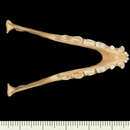en
names in breadcrumbs


Although not considered an at risk species, P. giganteus is subject to lethal, officially sanctioned control measures in many areas, including the Maldive Islands, Pakistan, and India, because of their negative effects on fruit orchards. Despite this negative impact, this species is protected and considered sacred by people in certain regions of India.
Communication among individuals of this species is vocal. They chatter and squawk when threatened. Typical of megachiropterans, P. giganteus does not echolocate, and relies on sight rather than hearing for navigation. Because of their use of vision, there is probably communication involving body postures and positioning. Tactile communication is important during mating, as well as between mothers and their offspring.
Communication Channels: visual ; tactile ; acoustic ; chemical
Perception Channels: visual ; tactile ; acoustic ; chemical
This species is listed in CITES Appendix II, meaning it is not currently threatened, but could become so if protective measures are not taken.
US Federal List: no special status
CITES: appendix ii
IUCN Red List of Threatened Species: least concern
Indian flying foxes cause extensive damage to fruit orchards, and are therefore considered pests in many regions. They may also be responsible for spreading disease, particularly the Nipah virus, which causes illness and death in humans.
Negative Impacts: injures humans (carries human disease); crop pest
Humans in some regions benefit from Indian flying foxes by hunting them for food and medicinal purposes.
Positive Impacts: food ; source of medicine or drug
This species, along with other species of the genus Pteropus, plays a role in seed dispersal. It is also eaten by snakes and raptors.
Ecosystem Impact: disperses seeds
Species Used as Host:
Mutualist Species:
Commensal/Parasitic Species:
Pteropus giganteus is frugivorous, as are other species of the Suborder Megachiroptera, otherwise known as the Old World fruit bats. This species has been reported to eat many different species of fruit, including guava, mango, and fig. An individual of the genus Pteropus squeezes out fruit juices from the pulp against the roof of its mouth, and then discards the dry material. Some Pteropus species also supplement their dietary protein by eating insects. Others, including P. giganteus, eat the blossoms and nectar of fruiting plants.
Plant Foods: fruit; nectar; flowers
Primary Diet: herbivore (Frugivore )
Pteropus giganteus occurs in tropical regions of South Central Asia, from Pakistan to China, and as far south as the Maldive Islands.
Biogeographic Regions: oriental (Native )
These animals can be found in forests and swamps. Large groups of individuals roost in trees such as banyan, fig, and tamarind. Roosting trees are usually in the vicinity of a body of water.
Habitat Regions: tropical
Terrestrial Biomes: forest ; rainforest
Wetlands: swamp
The longest lifespan of an individual of this species in captivity was recorded at 31 years, 5 months. Little information is available regarding life expectancy in the wild.
Range lifespan
Status: captivity: 31 (high) years.
Average lifespan
Status: captivity: 31.4 years.
The physical appearance of this species is similar to that of megachiropterans in general, with large eyes, simple ears, and no facial ornamentation. Dark brown, gray, or black body color with a contrasting yellowish mantle is typical of the genus Pteropus. Body mass ranges from 600 to 1600 g and males are generally larger than females. Wingspan may range from 1.2 to 1.5 m and body length averages 23 cm. Members of the genus Pteropus maintain body temperatures between 33 and 37 C, but must do this through constant activity.
Range mass: 600 to 1600 g.
Average length: 23 cm.
Range wingspan: 1.2 to 1.5 m.
Other Physical Features: endothermic ; heterothermic ; bilateral symmetry
Sexual Dimorphism: male larger
Average basal metabolic rate: 1.622 W.
Major predators of this species are humans, snakes and raptors.
Known Predators:
This species is polygynandrous, with no pair bonds occurring between males and females. Females are defended from intruding males by males that live in their roosting tree.
Mating System: polygynandrous (promiscuous)
Pteropus giganteus breeds yearly, with mating occurring from July to October, and births occurring from February to May. To initiate copulation, a male will fan his wings toward a female, and persistently follow her until he is able to grip the scruff of her neck with his teeth and hold her with his thumbs. Copulation occurs for a duration of 30 to 40 seconds. The female usually vocalizes and physically resists the advances of the male during the encounter. After copulation, the male again follows the female while vocalizing loudly. Gestation period is typically 140 to 150 days, after which 1 to 2 young are born. Like other members of the genus Pteropus, the young are carried by the mother for the first few weeks of life. Sexual maturity for this species occurs at about 1.5 years of age.
Breeding interval: Mating occurs once yearly.
Breeding season: Mating season is between the months of July and October.
Range number of offspring: 1 to 2.
Average number of offspring: 1.
Range gestation period: 140 to 150 days.
Average weaning age: 5 months.
Average age at sexual or reproductive maturity (female): 1.5 years.
Average age at sexual or reproductive maturity (male): 1.5 years.
Key Reproductive Features: iteroparous ; seasonal breeding ; gonochoric/gonochoristic/dioecious (sexes separate); sexual ; fertilization ; viviparous
Average birth mass: 45 g.
Average number of offspring: 1.
Average age at sexual or reproductive maturity (male)
Sex: male: 365 days.
Average age at sexual or reproductive maturity (female)
Sex: female: 365 days.
After birth, young are carried by the mother for the first three weeks of life. They begin to hang by themselves after this time period, but are still carried to feeding sites by the mother. Young learn to fly at about 11 weeks of age and are weaned at 5 months. Males do not participate in parental care.
Parental Investment: altricial ; pre-fertilization (Provisioning, Protecting: Female); pre-hatching/birth (Provisioning: Female, Protecting: Female); pre-weaning/fledging (Provisioning: Female, Protecting: Female); pre-independence (Protecting: Female); inherits maternal/paternal territory